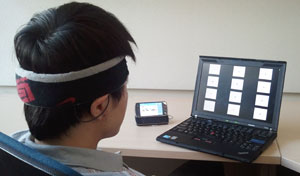Brain-Monitoring Technology Makes Media Waves
Rhonda McCoy | May 16, 2011

New brain-computer interface technology developed by UC San Diego researchers can help monitor the alertness of air-traffic controllers, and may enable hands-free dialing of cell phones and "smart" prosthetics.
Brain waves, particularly those being studied by UC San Diego researchers, have been making media waves. ABC News, KPBS, UCSD TV and other media outlets have all recently featured new brain-computer interface technology developed by Tzyy-Ping Jung and associates Yu-Te Wang and Yijun Wang of the Institute for Neural Computation. The innovative technology heralds a new and fast-advancing generation of mobile, wireless brain-activity-monitoring systems.
An immediately promising application, whose feasibility was first demonstrated by UCSD researchers Jung and Makeig in the 1990s, is to monitor the alertness of workers in a variety of occupations that require around-the-clock alertness, such as air traffic controllers, drivers and pilots, and nuclear power plant monitors.
Jung and collaborators Chin-Teng Lin, Jin-Chern Chiou, and associates at National Chiao-Tung University in Hinschu, Taiwan have developed a mobile, wireless, and wearable electroencephalographic headband system that contains dry scalp sensors that monitor the wearer’s brain waves via signals transmitted through a Bluetooth link that can be read by many cell phones and other mobile devices.
The system can continuously monitor the wearer’s level of alertness and cue appropriate feedback (for example, audible warning signals or other system alerts) to assist a drowsy worker in maintaining system performance.
Jung, a biomedical engineer, research scientist and associate director of the Swartz Center for Computational Neuroscience in the Institute for Neural Computation, says that the technology is almost production ready. “We’re trying to translate the technology from laboratory experiments to the real world, step by step.”
The same dry electrode technology has also been used to detect brain activity in response to visual stimuli flickering at specific frequencies, enabling hands-free dialing of a cell phone.
Using such a system, a severely handicapped person could summon emergency aid simply by focusing on the numbers of a keypad. This and similar “smart” prosthetics that respond to direct brain-signal commands may soon offer many new opportunities to disabled persons.
The Swartz Center for Neural Computation, directed by Scott Makeig, was founded in 2001 by a generous gift from founding donor Dr. Jerome Swartz of The Swartz Foundation (Old Field, New York). The center is currently also funded by grants from the Office of Naval Research, the Army Research Laboratory, The Army Research Office, DARPA, and the National Institutes of Health. Jung’s research is also supported in part by a gift from Abraxis Bioscience Inc.

|